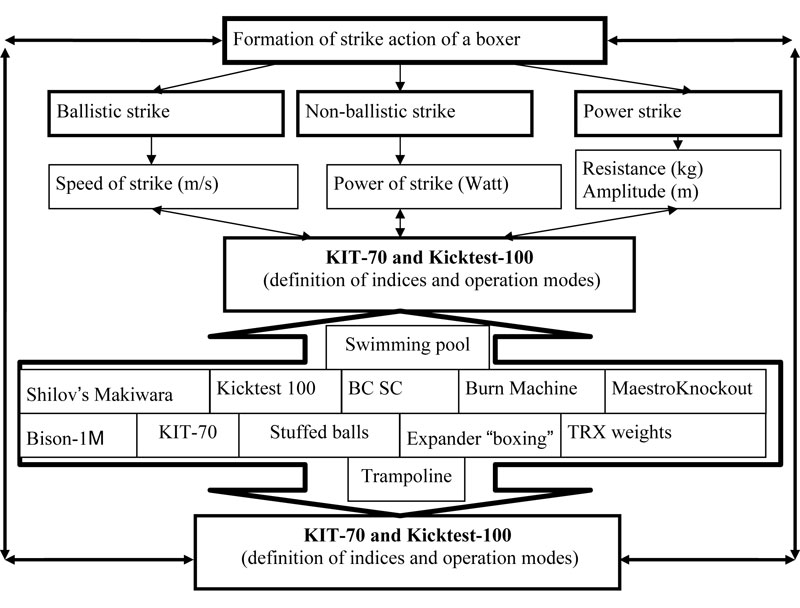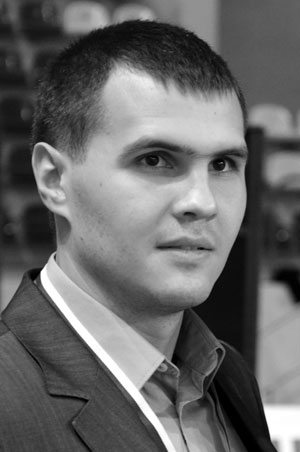Methodology of Formation of Strike Action in Boxing
Фотографии:
ˑ:
A.M. Yakupov, postgraduate student
M.Yu. Stepanov, associate professor, Ph.D.
Tchaikovsky State Institute of Physical Culture, Tchaikovsky
Key words: methods, strike action, boxing, control, physical performance.
Effectiveness of management of the training process of boxers is associated with planning and control of training session, choosing rational corrective actions based on the systematically incoming information on the urgent training effect in the artificial management environment [1]. As of today, there are no effective technologies of improvement of strike actions of boxers, which could help estimate changes while training biodynamic characteristics in real time [3, 4].
The purpose of the research was to develop the methodology of formation of strike actions in boxing.
Results and discussion. The methodology of formation of strike actions includes three main forms of strikes: ballistic, non-ballistic and power, which are different in their biodynamic and technical-tactical characteristics, therefore multiple means of varying intensity are used to form them.
The chart outlining the choice of techniques and intensity is shown in Figure.

Fig. The chart of formation of strike actions in boxing
The technique is based on the use of feedback (biodynamic characteristics) throughout the formation of a strike action [2, 5]. Assessment of biodynamic characteristics included the following: speed, power, number of strikes in series, amplitude, execution time measured using KIT-70, as well as strength, power, sharpness, number of strikes in series and their totals obtained with the help of the dynamic bag Kicktest-100. Evaluation of these parameters is the regulating factor for choosing techniques and intensity in boxers’ training [6, 7]. In order to determine the intensity of an exercise set performed using KIT-70, we apply the value of MAP (maximum anaerobic power) measured on this simulator. Thanks to measuring the indices of MAP (W/s), intensity (% of MAP), speed (m/s), amplitude (m), number of repetitions, exercise time (s) in the proposed exercise set using KIT-70, in addition to identification of local weaknesses in the biodynamic structure of a strike action, we can also set the optimal load and intensity to increase these indices during the follow-up (Table).
Table. Exercise set for control simulator
|
№
1
2
3
4
5 |
Operating (official) name of exercise |
Aim of exercise |
Kind/mode of operation |
Muscles involved in the exercise |
|
Direct blow |
To train direct blow technique |
Coping/single blow, speed 90% of the maximum, intensity 40-70% of MAP |
Calf muscles, gluteus maximus, biceps and quadriceps muscles of thigh, obliques, triceps brachii |
|
|
Direct blow (pulling arm back) |
To train pulling arm back within direct blow technique |
Coping/single blow, speed 90% of the maximum, intensity 40-70% of MAP |
Quadriceps muscles of thigh, obliques, latissimus dorsi, teres major and minor muscles, infraspinatus muscle, biceps brachii, deltoid muscle |
|
|
Hook |
To train hook technique |
Coping/single blow, speed 90% of the maximum, intensity 40-70% of MAP |
Calf muscles, gluteus maximus, biceps and quadriceps muscles of thigh, obliques, subscapularis muscle, pectoral muscles, latissimus dorsi, triceps and biceps brachii |
|
|
Hook (pulling arm back) |
Training to pull back one’s arm in hook technique |
Coping/single blow, speed 90% of the maximum, intensity 40-70% of MAP |
Quadriceps muscles of thigh, obliques, latissimus dorsi, teres major and minor muscles, infraspinatus muscle, biceps brachii, deltoid muscle |
|
|
Uppercut |
Uppercut technique formation |
Coping/single blow, speed 90% of the maximum, intensity 40-70% of MAP |
Calf muscles, gluteus maximus, biceps and quadriceps muscles of thigh, obliques, subscapularis muscle, pectoral muscle, latissimus dorsi, biceps brachii |
|
|
6.
7. |
Boxing footwork |
Main leg push forward the in strike actions |
Coping/single blow, speed 90% of the maximum, intensity 40-70% of MAP |
Calf muscles, gluteus maximus, vastus lateralis, sartorius, gracilis muscle, biceps and quadriceps muscles of thigh |
|
Boxing footwork (backwards) |
Main leg push backward in strike actions |
Coping/single blow, speed 90% of the maximum, intensity 40-70% of MAP |
Anterior tibial muscle, biceps and quadriceps muscles of thigh, vastus muscle, sartorius, gracilis muscle |
This method is implemented in a computer program, the essence of which is to provide objective assessment of exercise performance and save the data for further analysis and selection of the optimal load and intensity. Thanks to applying and using the data obtained with the help of these sets the means can be used purposefully with the optimal loading effort, optimal speed and energy of performance of the suggested exercise. Thus, speed is the main control parameter for the formation of ballistic strikes. The following exercises are used to form this strike: exercises with small weights; expander “box”; Burn Machine simulator (1.8 kg); makiwara of Shilov with minimal load; KIT-70 exercise set in the single-strike mode, where the simulator signals in case the speed of strike drops by 10% of the maximum; dynamic bag, its operation mode is regulated by the number of strikes performed; lightweight stuffed balls from different positions; strikes performed while jumping on a trampoline and in water; exercises performed on the simulator Bison-1M simulate impact movements performed at high speed; exercises performed in TRX loops require force enough for 30 repetitions.
Power and amplitude of movement are the main control parameters for the formation of non-ballistic strikes. The mode of strikes performance using KIT-70 is that of MAP (maximum anaerobic power). The load is selected so as to reach maximum power in a separate move and ends if power drops by 10%. The weight of the stuffed balls is selected on the basis of indications received from MAP of the KIT-70 simulator. The simulator to be used is Burn Machine (3.7 kg). The load on the makiwara of Shilov is defined individually with compulsory touching of the movable part of the support. Mode of operation of 5 and 10 tons within the minimum time is used while training with the dynamic bag, the number of sets depends on the increase of time in the set by more than 10% over the record. Strikes in water with additional resistance. Trampoline exercises. Exercises performed on the simulator Bison-1M are of the static-dynamic nature. Exercises in TRX loops are performed in the circuit training mode in which case a separate training session is dedicated to them, or they are performed in the toning mode as a cool down.
When forming a power strike, large muscle groups need to be engaged. To engage the large muscle groups in the strike action the initial and final phases of a strike are mainly worked at. A MAP effort is selected for each phase when a strike action is divided into them. The selection is also carried out using KIT-70. Working on the phases of the strike action is conducted similar to that for non-ballistic strikes, but the load is considerably higher due to the use of large muscle groups.
The choice of exercises depends on the dynamic bag and KIT-70 tests performance. For example, at high performance the KIT-70 indicators and average results in the dynamic bag test, the training session is intended to strengthen the striking surface of fists. To this end, in addition to CP and SCP, it is necessary to use the makiwara of Shilov and the simulator MaestroKnockout. At low speeds demonstrated on KIT-70 the limiting speed factor is primarily determined. We use the KIT-70 exercise set to assess it and on the basis of the data obtained reveal weaknesses in training (take-off, turn of the body, straightening of one’s arm…). After identifying the limiting factor an exercise set is designed aimed at increasing strength indices. The water and trampoline exercise set is mainly used, the operation mode using KIT-70 is set depending on the individual maximum speed, and the simulator signals in case of its drop by 10%. The Burn Machine simulator (1.8 kg) is used in the mode of 10-second spurts.
Conclusion. Thanks to the proposed technique a wide range of methods can be used for operational control of physical parameters with further saving them in the computer; their analysis helps effectively choose exercises based on load and intensity.
References
- Ratov, I.P. Human motor abilities: conventional methods of their development and recovery. - Minsk, 1994. – 116 P. (In Russian)
- Stepanov, M.Yu. Relationship of dynamic characteristics of strike actions and physical fitness of young boxers aged 11-16 years in the dynamics of training camp / M.Yu. Stepanov, I.V. Demin, A.M. Yakupov // Proceedings of the All-Rus. theor.-pract. conf. Yekaterinburg: Ural Institute of Law, Ministry of Internal Affairs of Russia. – P. 13–18. (In Russian)
- Stepanov, M.Yu. Monitoring and test simulator (KIT-70) for development of power and efficiency of muscle contraction // Proceedings of the All-Rus. theor.-pract. conf. Yekaterinburg: Ural Institute of Law, Ministry of Internal Affairs of Russia. – P. 89–91. (In Russian)
- Stepanov, M.Yu. Special training and measuring complex for development of speed and strength abilities // Innovative approaches and modern technologies in vocational training in universities of physical culture and training of students for participation in Russian and international competitions: Proceedings of the All-Rus. theor.-pract. conf. – Kazan: VSAPCST, 2011. – P. 315–317. (In Russian)
- Stepanov, M.Yu. The use of special devices for the purposeful improvement of fitness of single combat wrestlers // Proceedings of the All-Rus. theor.-pract. conf. with internat. participation. – Yekaterinburg: UrFU, 2011. P. 113–118. (In Russian)
- Stepanov, M.Yu. Description, characteristics and advantages of the monitoring and test simulator (KIT-70) / M.Yu. Stepanov, E.Yu. Makshakova, A.M. Yakupov // Proceedings of the All-Rus. theor.-pract. conf. – Tchaikovsky: CSIPC, 2014. – P. 127–130. (In Russian)
- Stepanov, M.Yu., Makshakova, E.Yu., Yakupov, A.M. Characteristics of exercises performed on inertia-free speed-strength simulators to form a strike in boxing // Proceedings of the All-Rus. theor.-pract. conf. – Tchaikovsky: CSIPC, 2014. – P. 130–133. (In Russian)
- Stepanov, M.Yu., Yakupov, A.M. Analysis of correlations of exercises forming strike actions in young boxers // Proceedings of the All-Rus. theor.-pract. conf. with internat. partic. – Perm: PMI IT MIA Russia, 2014. – P. 369-375. (In Russian)
Corresponding author: stepanov_m@inbox.ru


